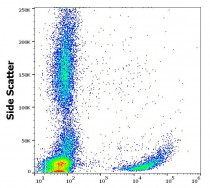ARG62846
anti-CD42b antibody [HIP1]
anti-CD42b antibody [HIP1] for CyTOF®-candidate,Flow cytometry,Functional study,IHC-Frozen sections and Human,Primates
Cell Biology and Cellular Response antibody; Immune System antibody
Overview
| Product Description | Mouse Monoclonal antibody [HIP1] recognizes CD42b |
|---|---|
| Tested Reactivity | Hu, NHuPrm |
| Tested Application | CyTOF®-candidate, FACS, FuncSt, IHC-Fr |
| Specificity | The clone HIP1 reacts with CD42b (GPIb alpha), a 135-145 kDa membrane glycoprotein expressed on platelets and megakaryocytes. CD42b and CD42c (GPIb beta) are composed in a disulfide linked heterodimer (CD42b/c; 160 kDa); CD42b/c forms a noncovalent complex with CD42a and CD42d. HLDA IV; WS Code P 40 |
| Host | Mouse |
| Clonality | Monoclonal |
| Clone | HIP1 |
| Isotype | IgG1 |
| Target Name | CD42b |
| Immunogen | Peripheral blood mononuclear cells of a patient suffering with CLL. |
| Conjugation | Un-conjugated |
| Alternate Names | CD antigen CD42b; Antigen CD42b-alpha; DBPLT3; VWDP; CD42B; GP-Ib alpha; Glycoprotein Ibalpha; BDPLT1; BSS; CD42b-alpha; GPIbA; GPIb-alpha; Platelet glycoprotein Ib alpha chain; BDPLT3; GP1B |
Application Instructions
| Application Suggestion |
|
||||||||||
|---|---|---|---|---|---|---|---|---|---|---|---|
| Application Note | Functional studies: The clone HIP1 inhibits the ristocetin-dependent binding of von Willebrand Factor (vWF) to platelets and ristocetin-induced platelet agglutination. * The dilutions indicate recommended starting dilutions and the optimal dilutions or concentrations should be determined by the scientist. |
Properties
| Form | Liquid |
|---|---|
| Purification | Purified by protein A |
| Purity | > 95% (by SDS-PAGE) |
| Buffer | PBS (pH 7.4) and 15 mM Sodium azide |
| Preservative | 15 mM Sodium azide |
| Concentration | 1 mg/ml |
| Storage Instruction | For continuous use, store undiluted antibody at 2-8°C for up to a week. For long-term storage, aliquot and store at -20°C or below. Storage in frost free freezers is not recommended. Avoid repeated freeze/thaw cycles. Suggest spin the vial prior to opening. The antibody solution should be gently mixed before use. |
| Note | For laboratory research only, not for drug, diagnostic or other use. |
Bioinformation
| Database Links |
Swiss-port # P07359 Human Platelet glycoprotein Ib alpha chain |
|---|---|
| Gene Symbol | GP1BA |
| Gene Full Name | glycoprotein Ib (platelet), alpha polypeptide |
| Background | CD42b (GPIb alpha) composes together with GPIb beta, GPIX and GPV the GPIb-IX-V receptor complex critical in the process of platelet-rich thrombus formation by tethering the platelet to a thrombogenic surface. CD42b binds to von Willebrand factor (VWF) exposed at a site of vascular injury, as well as to thrombin, coagulation factors XI and XII, high molecular wight kininogen, TSP-1, integrin Mac-1 and P-selectin. The extracellular domain of CD42b by its interactions also contributes to metastasis. |
| Function | GP-Ib, a surface membrane protein of platelets, participates in the formation of platelet plugs by binding to the A1 domain of vWF, which is already bound to the subendothelium. [UniProt] |
| Highlight | Related products: CD42b antibodies; Anti-Mouse IgG secondary antibodies; Related news: CyTOF-candidate Antibodies |
| Research Area | Cell Biology and Cellular Response antibody; Immune System antibody |
| Calculated MW | 72 kDa |
| PTM | Glycocalicin, which is approximately coextensive with the extracellular part of the molecule, is cleaved off by calpain during platelet lysis. |
Images (2) Click the Picture to Zoom In
-
ARG62846 anti-CD42b antibody [HIP1] FACS image
Flow Cytometry: Human peripheral blood cells stained with ARG62846 anti-CD42b antibody [HIP1] at 4 µg/ml dilution, followed by APC-conjugated Goat anti-Mouse antibody.
-
ARG62846 anti-CD42b antibody [HIP1] FACS image
Flow Cytometry: Separation of human thrombocytes (red-filled) from CD42b negative lymphocytes (black-dashed). Human peripheral whole blood stained with ARG62846 anti-CD42b antibody [HIP1] at 4 µg/ml dilution, followed by APC-conjugated Goat anti-Mouse antibody.









